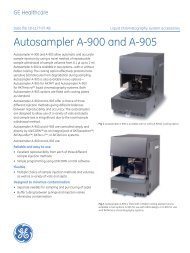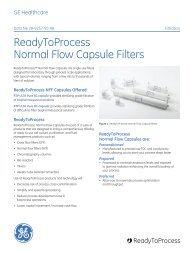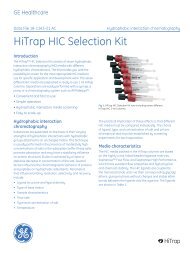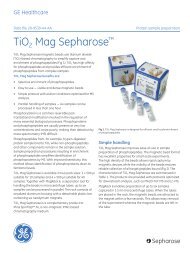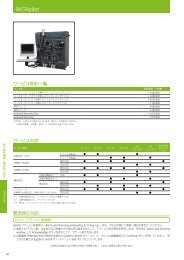StrepTactin Sepharose High Performance StrepTrap HP
StrepTactin Sepharose High Performance StrepTrap HP
StrepTactin Sepharose High Performance StrepTrap HP
Create successful ePaper yourself
Turn your PDF publications into a flip-book with our unique Google optimized e-Paper software.
GE Healthcare<br />
Data file 28-9136-31 AB<br />
Affinity purification<br />
<strong>StrepTactin</strong> <strong>Sepharose</strong> <strong>High</strong> <strong>Performance</strong><br />
<strong>StrepTrap</strong> <strong>HP</strong><br />
<strong>StrepTactin</strong> <strong>Sepharose</strong> <strong>High</strong> <strong>Performance</strong> is a chromatography<br />
medium for purifying Strep(II)-tagged recombinant<br />
proteins. The medium is available in 10 ml and 50 ml lab<br />
packs and prepacked in 1 ml and 5 ml <strong>StrepTrap</strong> <strong>HP</strong><br />
columns.<br />
The Strep(II) tag is a small tag consisting of only eight amino<br />
acids (Trp-Ser-His-Pro-Gln-Phe-Glu-Lys) and a relative<br />
molecular mass (M r ) of only 1000. The small size of the tag is<br />
very beneficial, since in most cases it does not interfere with<br />
structural and functional studies and, therefore, does not<br />
have to be removed from the target protein. The Strep(II) tag<br />
binds very specifically to the immobilized <strong>StrepTactin</strong><br />
ligand giving pure target protein. Affinity purification using<br />
<strong>StrepTactin</strong> <strong>Sepharose</strong> <strong>High</strong> <strong>Performance</strong> takes place under<br />
physiological conditions, and mild elution with desthiobiotin<br />
preserves the activity of the target protein.<br />
<strong>StrepTactin</strong> <strong>Sepharose</strong> <strong>High</strong> <strong>Performance</strong> benefits:<br />
• <strong>High</strong>ly pure Strep(II)-tagged recombinant proteins eluted<br />
in concentrated form and small volumes<br />
• Physiological conditions and mild elution preserve target<br />
protein activity<br />
• Fast and easy regeneration with 0.5 M NaOH<br />
• Compatible with a wide range of reducing agents,<br />
detergents, denaturants and other additives<br />
• Prepacked <strong>StrepTrap</strong> <strong>HP</strong> 1 ml and 5 ml columns offer<br />
convenience, save time, and ensure reproducible results<br />
• Easy scale-up<br />
Fig 1. <strong>StrepTactin</strong> <strong>Sepharose</strong> <strong>High</strong> <strong>Performance</strong>, also prepacked as<br />
<strong>StrepTrap</strong> <strong>HP</strong> columns, give fast and convenient affinity purifications of<br />
Strep(II)-tagged recombinant proteins.<br />
Description<br />
Chromatography medium characteristics<br />
<strong>StrepTactin</strong> is a specially-engineered streptavidin ligand.<br />
The binding affinity of the Strep(II)-tag to the immobilized<br />
ligand is nearly 100-fold higher than to streptavidin, making<br />
<strong>StrepTactin</strong> <strong>Sepharose</strong> <strong>High</strong> <strong>Performance</strong> ideal for purifying<br />
Strep(II)-tagged proteins.<br />
The small bead size (average 34 µm) of the <strong>Sepharose</strong> <strong>High</strong><br />
<strong>Performance</strong> matrix results in high-resolution separations,<br />
sharp peaks and purified target proteins in a concentrated<br />
form. <strong>StrepTactin</strong> <strong>Sepharose</strong> <strong>High</strong> <strong>Performance</strong> is<br />
compatible with a wide range of additives, tolerates all<br />
commonly used aqueous buffers, and is quickly and easily<br />
regenerated using 0.5 M NaOH.<br />
<strong>StrepTrap</strong> <strong>HP</strong> column characteristics<br />
The columns are 1 ml and 5 ml HiTrap columns made of<br />
biocompatible polypropylene that does not interact with<br />
biomolecules. Prepacked <strong>StrepTrap</strong> <strong>HP</strong> columns provide<br />
fast and simple purifications in a convenient format are<br />
delivered with a stopper on the inlet and a snap-off end on<br />
the outlet. Porous top and bottom frits allow high flow rates.<br />
imagination at work
The columns can be operated either with a syringe, a<br />
peristaltic pump, or a chromatography system such as<br />
ÄKTAdesign . Note that HiTrap columns cannot be opened<br />
or refilled.<br />
Tables 1 and 2 summarize the characteristics of <strong>StrepTactin</strong><br />
<strong>Sepharose</strong> <strong>High</strong> <strong>Performance</strong> and <strong>StrepTrap</strong> <strong>HP</strong> columns,<br />
respectively. Table 3 lists the compatibility of the<br />
<strong>StrepTactin</strong> <strong>Sepharose</strong> <strong>High</strong> <strong>Performance</strong> medium with<br />
different additives.<br />
Table 1. Characteristics of <strong>StrepTactin</strong> <strong>Sepharose</strong> <strong>High</strong> <strong>Performance</strong><br />
Matrix<br />
Rigid, highly cross-linked<br />
6% agarose<br />
Average particle size 34 µm<br />
Ligand<br />
<strong>StrepTactin</strong><br />
Ligand concentration Approx. 5 mg/ml medium<br />
Dynamic binding capacity 1<br />
Approx. 6 mg Strep(II)-tagged<br />
protein/ml medium<br />
Recommended flow rate 2<br />
≤ 150 cm/h<br />
Maximum linear flow rate 2<br />
< 300 cm/h<br />
Maximum back pressure 2<br />
0.3 MPa, 3 bar<br />
Chemical stability<br />
Stable in all commonly used<br />
buffers, reducing agents, and<br />
detergents (see Table 3), as well as<br />
0.5 M NaOH (regeneration and<br />
cleaning)<br />
pH stability (working range) > 7<br />
Storage<br />
4°C to 8°C in 20% ethanol<br />
1<br />
2<br />
Binding capacity is protein dependent. Dynamic binding capacity was tested with GAPDH-<br />
Strep(II), M r 37 400<br />
H 2 O at room temperature<br />
Table 2. Characteristics of <strong>StrepTrap</strong> <strong>HP</strong><br />
Column volumes<br />
Column dimensions<br />
Recommended flow rates 1<br />
Maximum flow rates 1<br />
Maximum back pressure 1<br />
1<br />
H 2 O at room temperature<br />
1 ml or 5 ml<br />
0.7 × 2.5 cm (1 ml)<br />
1.6 × 2.5 cm (5 ml)<br />
1 and 5 ml/min for 1 and 5 ml<br />
columns, respectively<br />
4 and 20 ml/min for 1 and 5 ml<br />
columns, respectively<br />
0.3 MPa, 3 bar<br />
Table 3. Compatibility of <strong>StrepTactin</strong> <strong>Sepharose</strong> <strong>High</strong> <strong>Performance</strong> with<br />
different additives 1<br />
Reagent<br />
Reduction agents<br />
DTT<br />
b-mercaptoethanol<br />
Nonionic detergents<br />
Concentration<br />
50 mM<br />
50 mM<br />
C8E4, Octyltetraoxyethylene max. 0.88%<br />
C10E5, Decylpentaoxyethylene 0.12%<br />
C10E6 0.03%<br />
C12E8 0.005%<br />
C12E9, Dodecyl nonaoxyethylene (Thesit) 0.023%<br />
Decyl-b-D-maltoside 0.35%<br />
N-dodecyl-b-D-maltoside 0.007%<br />
N-nonyl-b-D-glucopyranoside 0.2%<br />
N-octyl-b-D-glucopyranoside 2.34%<br />
Triton X-100 2%<br />
Tween 20 2%<br />
Ionic detergents<br />
N-lauryl-sarcosine 2%<br />
8-HESO; N-octyl-2-hydroxy-ethylsulfoxide 1.32%<br />
SDS, Sodium-N-dodecyl sulfate 0.1%<br />
Zwitterionic detergents<br />
CHAPS 0.1%<br />
DDAO, N-decyl-N,N-dimethylamine-N-oxide 0.034%<br />
LDAO, N-dodecyl-N,N-dimethylamine-N-oxide 0.13%<br />
Others<br />
Ammonium sulfate, (NH 4 ) 2 SO 4<br />
CaCl 2<br />
EDTA<br />
Guanidine<br />
2 M<br />
max. 1 M<br />
50 mM<br />
max. 1 M<br />
Glycerol max. 25% 2<br />
Imidazole 500 mM 3<br />
MgCl 2<br />
Urea<br />
NaCl<br />
1<br />
2<br />
3<br />
1 M<br />
max. 1 M<br />
5 M<br />
Data kindly provided by IBA GmbH, Germany, the manufacturer and IP owner of the<br />
<strong>StrepTactin</strong> ligand<br />
Yield may decrease<br />
500 mM imidazole in sample tested by GE Healthcare<br />
Note: These reagents have been successfully tested for the purification of, for example,<br />
GAPDH-Strep(II) with concentrations up to those listed. <strong>High</strong>er concentrations<br />
may, however, be possible for reagents not marked with “max”. Since binding<br />
depends on the sterical accessibility of the Strep(II) tag in the context of the particular<br />
protein, the possible concentration can deviate from the given value for other<br />
proteins<br />
<br />
Data file 28-9136-31 AB
Use and applications<br />
Packing in laboratory columns<br />
<strong>StrepTactin</strong> <strong>Sepharose</strong> <strong>High</strong> <strong>Performance</strong> is supplied preswollen<br />
in 10 ml and 50 ml packs. The medium is easy to<br />
pack and use in, for example, laboratory columns from the<br />
Tricorn and XK series (see Ordering information). Full user<br />
instructions are supplied with each pack.<br />
<strong>StrepTrap</strong> <strong>HP</strong><br />
Purifications on <strong>StrepTrap</strong> <strong>HP</strong> 1 ml and 5 ml are easily<br />
performed using a syringe and the provided Luer adapter<br />
(Fig 2), a laboratory pump, or a chromatography system such<br />
as ÄKTAdesign. Instructions and connectors are included.<br />
Increased purity with a two-step affinity<br />
purification of a dual-tagged protein<br />
A dual-tagged Strep(II)-(histidine) 6 protein (M r ~15 400)<br />
expressed in E. coli was purified for method development<br />
of functional studies. The two-step procedure comprised<br />
immobilized metal affinity chromatography (IMAC)<br />
on HisTrap <strong>HP</strong> (prepacked with Ni <strong>Sepharose</strong> <strong>High</strong><br />
<strong>Performance</strong>) followed by affinity chromatography on<br />
<strong>StrepTrap</strong> <strong>HP</strong>. As high purity is crucial for successful<br />
functional studies, purity results of the two-step method<br />
were compared to the IMAC and affinity chromatography<br />
steps individually. All runs were performed on ÄKTAxpress <br />
at 4°C. The conditions used are shown below:<br />
Individual HisTrap <strong>HP</strong> purification<br />
A B C D<br />
Column: HisTrap <strong>HP</strong> 1 ml<br />
Sample: Strep(II)-(histidine) 6 protein (M r ~15 400) in E. coli lysate<br />
Sample volume: 15 ml<br />
Binding buffer: 20 mM sodium phosphate, 500 mM NaCl, 20 mM imidazole, pH 7.5<br />
Elution buffer: 20 mM sodium phosphate, 500 mM NaCl, 500 mM imidazole, pH 7.5<br />
Flow rate: 0.8 ml/min<br />
System: ÄKTAxpress<br />
Individual <strong>StrepTrap</strong> <strong>HP</strong> purification<br />
A B C D<br />
Column: <strong>StrepTrap</strong> <strong>HP</strong> 1 ml<br />
Sample: Strep(II)-(histidine) 6 protein (M r ~15 400) in E. coli lysate<br />
Sample volume: 15 ml<br />
Binding buffer: 100 mM Tris-HCl, 150 mM NaCl, 1 mM EDTA, pH 8.0<br />
Elution buffer: 2.5 mM desthiobiotin in binding buffer<br />
Flow rate: 0.8 ml/min<br />
System: ÄKTAxpress<br />
Two-step HisTrap <strong>HP</strong> and <strong>StrepTrap</strong> <strong>HP</strong> purification<br />
Column: HisTrap <strong>HP</strong> 1 ml<br />
Sample: Strep(II)-(histidine) 6 protein (M r ~15 400) in E. coli lysate<br />
Sample volume: 15 ml<br />
Binding buffer: 20 mM sodium phosphate, 500 mM NaCl, 20 mM imidazole, pH 7.5<br />
Elution buffer: 20 mM sodium phosphate, 500 mM NaCl, 500 mM imidazole, pH 7.5<br />
Flow rate: 0.8 ml/min<br />
System: ÄKTAxpress<br />
B C D<br />
Fig 2. Using <strong>StrepTrap</strong> <strong>HP</strong> 1 ml with a syringe. (A) Prepare buffers and<br />
sample. Remove the column’s top cap and snap off the end. Wash and<br />
equilibrate. (B) Load the sample and begin collecting fractions. (C) Elute<br />
and continue collecting fractions.<br />
Column:<br />
Sample:<br />
<strong>StrepTrap</strong> <strong>HP</strong> 1 ml<br />
Eluted fraction from HisTrap <strong>HP</strong>, 1 ml<br />
Binding buffer: 100 mM Tris-HCl, 150 mM NaCl, 1 mM EDTA, pH 8.0<br />
Elution buffer:<br />
Flow rate:<br />
System:<br />
2.5 mM desthiobiotin in binding buffer<br />
0.2 ml/min<br />
ÄKTAxpress<br />
SDS-PAGE analysis (Fig 3) showed that the individual<br />
HisTrap <strong>HP</strong> purification yielded the target protein and a<br />
number of different impurities (lane 3). <strong>StrepTrap</strong> <strong>HP</strong> on<br />
its own also yielded the target protein, this time with one<br />
impurity (lane 6). In contrast, the combination of HisTrap <strong>HP</strong><br />
followed by <strong>StrepTrap</strong> <strong>HP</strong> resulted in a target protein with a<br />
purity greater than 95% (lane 5).<br />
This example clearly demonstrates the benefits of a dualtagged<br />
approach to protein purification, especially when<br />
high purity is needed for applications such as functional<br />
studies. HisTrap <strong>HP</strong> and <strong>StrepTrap</strong> <strong>HP</strong> run in sequence on<br />
ÄKTAxpress fulfilled the requirements for a fast and efficient<br />
chromatography system capable of delivering such results.<br />
Data file 28-9136-31 AB
M r<br />
188 000<br />
98 000<br />
62 000<br />
49 000<br />
38 000<br />
28 000<br />
17 000<br />
14 000<br />
6 000<br />
3 000<br />
1 2 3 4 5 6 7<br />
Lane<br />
1. Molecular weight markers<br />
2. Flowthrough, individual HisTrap <strong>HP</strong><br />
3. Eluted pool, individual HisTrap <strong>HP</strong><br />
4. Flowthrough, HisTrap <strong>HP</strong> + <strong>StrepTrap</strong> <strong>HP</strong><br />
5. Eluted pool, HisTrap <strong>HP</strong> + <strong>StrepTrap</strong> <strong>HP</strong><br />
6. Eluted pool, individual <strong>StrepTrap</strong> <strong>HP</strong><br />
7. Flowthrough, individual <strong>StrepTrap</strong> <strong>HP</strong><br />
Fig 3. SDS-PAGE analysis (reduced conditions) comparing individual<br />
purifications on HisTrap <strong>HP</strong> 1 ml and <strong>StrepTrap</strong> <strong>HP</strong> 1 ml with a combined,<br />
two-step affinity purification on both columns.<br />
Regeneration with NaOH<br />
Regenerating <strong>StrepTrap</strong> <strong>HP</strong> prior to performing the next<br />
purification will help retain chromatographic performance<br />
and promote cost-effective use. The columns can easily be<br />
regenerated using two protocols either with 0.5 M NaOH<br />
(approx. 10 min) or 1 mM HABA (2-[4’-hydroxy-benzeneazo]<br />
benzoic acid (approx. 25 min). This example shows<br />
regeneration with NaOH, which is fast, simple and effective.<br />
GAPDH-Strep(II) (M r ~37 400) was purified on <strong>StrepTrap</strong><br />
<strong>HP</strong> 1 ml. Six repetitive runs were made with regeneration<br />
using 0.5 M NaOH between each run. Figure 4 shows the<br />
overlayed chromatograms from these six runs, illustrating<br />
the very high reproducibility of <strong>StrepTrap</strong> <strong>HP</strong> columns.<br />
Further analysis by capillary electrophoresis demonstrated<br />
high purities (more than 97% in all six runs, data not shown),<br />
a result confirmed by SDS-PAGE analysis (Fig 5). Recovery<br />
was also high (greater than 80%) and very consistent<br />
throughout the entire study (Fig 6). The UV measurements<br />
were performed using a plate reader.<br />
Column:<br />
<strong>StrepTrap</strong> <strong>HP</strong> 1 ml<br />
Sample:<br />
Strep(II)-tagged glyceraldehyde-phosphodehydrogenase<br />
(GAPDH-Strep[II], M r ~37 400), 1.0 mg/ml in E. coli lysate<br />
Sample volume: 1 ml<br />
Binding buffer: 100 mM Tris-HCl, 150 mM NaCl, 1 mM EDTA, pH 8.0<br />
Elution buffer:<br />
2.5 mM desthiobiotin in binding buffer<br />
Regeneration:<br />
3 ml distilled water, 3 ml 0.5 M NaOH, 3 ml distilled water<br />
Re-equilibration: 5 ml binding buffer<br />
Flow rate:<br />
1.0 ml/min<br />
(0.5 ml/min with NaOH)<br />
System:<br />
ÄKTAexplorer <br />
Elution buffer<br />
mAU<br />
%B<br />
100<br />
6000<br />
5000<br />
4000<br />
3000<br />
2000<br />
1000<br />
0<br />
0<br />
0 5 10 15 20 25 ml<br />
Fig 4. Six repetitive GAPDH-Strep(II) purification runs on the same<br />
<strong>StrepTrap</strong> <strong>HP</strong> 1 ml column.<br />
M r<br />
97 000<br />
66 000<br />
45 000<br />
30 000<br />
20 100<br />
14 400<br />
1 2 3 4 5 6 7 8<br />
Lane<br />
1. Low molecular weight markers<br />
2. Start material, E. coli lysate with GAPDH-Strep(II)<br />
3. Run 1, eluted pool<br />
4. Run 2, eluted pool<br />
5. Run 3, eluted pool<br />
6. Run 4, eluted pool<br />
7. Run 5, eluted pool<br />
8. Run 6, eluted pool<br />
Fig 5. SDS-PAGE analysis (reduced conditions) of the six repetitive<br />
purifications runs in the regeneration study shows excellent<br />
reproducibility.<br />
80<br />
60<br />
40<br />
20<br />
<br />
Data file 28-9136-31 AB<br />
Recovery (%)<br />
100<br />
90<br />
80<br />
70<br />
60<br />
50<br />
40<br />
30<br />
20<br />
10<br />
0<br />
1 2 3 4 5 6<br />
Run<br />
Fig 6. Recovery in the eluted fractions was retained over six<br />
purification runs.
Scaling up<br />
Scale-up can be achieved by increasing the bed volume<br />
while keeping the residence time constant. This approach<br />
maintains chromatographic performance during scale-up.<br />
For quick scale-up, two or more <strong>StrepTrap</strong> <strong>HP</strong> columns can<br />
be connected in series by connecting columns in series.<br />
Note, however, that this may increase backpressure on<br />
the column. The scale-up study below describes the first<br />
approach.<br />
The protein used was a dual-tagged fluorescent protein,<br />
(His) 6 -mCherry-Strep(II), in E. coli lysate, which can be<br />
detected at 587 nm as well as 280 nm. Purification on a<br />
<strong>StrepTrap</strong> <strong>HP</strong> 1 ml column was first performed and then<br />
scaled up to the 5 ml column followed by further scaleup<br />
to a 29 ml XK 26/20 column packed with <strong>StrepTactin</strong><br />
<strong>Sepharose</strong> <strong>High</strong> <strong>Performance</strong>. The protein load was<br />
increased five-fold in each step and the residence time was<br />
~2 min for all columns.<br />
Figure 7 shows the chromatograms and running conditions.<br />
Protein load was increased five-fold for the scale-up<br />
from the 1 ml <strong>StrepTrap</strong> <strong>HP</strong> column to the 5 ml column<br />
and 25-fold in the scale-up from the 5 ml <strong>StrepTrap</strong> <strong>HP</strong><br />
column to the 29 ml XK 26/20 column. Yield, calculated<br />
from absorbance measurements, was 2.2, 9.4 and 52.7 mg,<br />
respectively (Table 4). SDS-PAGE (data not shown) showed<br />
that the purity of the fractions eluted from the columns was<br />
similar.<br />
The columns gave comparable results, confirming the<br />
ease and reproducibility of scaling up purifications from<br />
<strong>StrepTrap</strong> <strong>HP</strong> columns to a larger, XK 26/20 column packed<br />
with <strong>StrepTactin</strong> <strong>Sepharose</strong> <strong>High</strong> <strong>Performance</strong>.<br />
Column:<br />
<strong>StrepTrap</strong> <strong>HP</strong> 1 ml<br />
<strong>StrepTrap</strong> <strong>HP</strong> 5 ml<br />
<strong>StrepTactin</strong> <strong>Sepharose</strong> <strong>High</strong> <strong>Performance</strong> packed in<br />
XK 26/20, 29 ml, bed height 5.5 cm<br />
Sample:<br />
(His) 6 -mCherry-Strep(II) (M r ~31 000), in E. coli lysate<br />
Sample volume: 4.2 ml (<strong>StrepTrap</strong> <strong>HP</strong> 1 ml)<br />
21 ml (<strong>StrepTrap</strong> <strong>HP</strong> 5 ml)<br />
105 ml (XK 26/20 column)<br />
Regeneration:<br />
3 column volumes (CV) distilled water, 3 CV 0.5 M NaOH,<br />
3 CV distilled water<br />
Binding buffer: 100 mM Tris-HCl, 150 mM NaCl, 1 mM EDTA, pH 8.0<br />
Elution buffer:<br />
2.5 mM desthiobiotin in binding buffer<br />
Flow rate:<br />
<strong>StrepTrap</strong> <strong>HP</strong> 1 ml: 1.0 ml/min (0.5 ml/min during sample<br />
loading and regeneration with 0.5 M NaOH)<br />
<strong>StrepTrap</strong> <strong>HP</strong> 5 ml: 5.0 ml/min (2.5 ml/min during sample<br />
loading and regeneration with 0.5 M NaOH)<br />
XK 26/20 column: 13 ml/min (6.5 ml/min during<br />
regeneration with 0.5 M NaOH)<br />
System:<br />
ÄKTAexplorer<br />
A mAUB C D<br />
3000<br />
2000<br />
1000<br />
A B mAU C D<br />
0<br />
3000<br />
2000<br />
= A 280<br />
= A 587<br />
= Elution buffer, %B<br />
0.0 10.0 20.0 ml<br />
mAU<br />
3000<br />
2000<br />
1000<br />
0<br />
mAU<br />
3000<br />
2000<br />
Table 4. Overview of the yield for <strong>StrepTrap</strong> <strong>HP</strong> and XK 26/20 column.<br />
1000<br />
1000<br />
Column<br />
Yield (mg)<br />
<strong>StrepTrap</strong> <strong>HP</strong>, 1 ml 2.2<br />
0<br />
<strong>StrepTrap</strong> <strong>HP</strong>, 5 ml 9.4<br />
0 50 100 ml<br />
XK 26/20 packed with <strong>StrepTactin</strong> <strong>Sepharose</strong><br />
<strong>High</strong> <strong>Performance</strong>, 29 ml<br />
A<br />
52.7 B C mAU D<br />
3000<br />
0<br />
mAU<br />
3000<br />
2000<br />
2000<br />
1000<br />
1000<br />
0<br />
0<br />
0 200 400 600 ml<br />
Fig 7. Scaling up the purification of (His) 6 -mCherry-Strep(II), (A)<br />
<strong>StrepTrap</strong> <strong>HP</strong> 1 ml, (B) <strong>StrepTrap</strong> <strong>HP</strong> 5 ml, (C) <strong>StrepTactin</strong> <strong>Sepharose</strong> <strong>High</strong><br />
<strong>Performance</strong> XK 26/20, 29 ml.<br />
Data file 28-9136-31 AB
Reproducible, automated two-step purifications<br />
by affinity chromatography of (His) 6 -mCherry-<br />
Strep(II)<br />
The dual-tagged red fluorescent protein, (His) 6 -mCherry-<br />
Strep(II) (M r ~31 000), was purified using an automated twostep<br />
affinity chromatography purification on a <strong>StrepTrap</strong><br />
<strong>HP</strong> 1 ml (to bind the Strep[II] tag) and HisTrap <strong>HP</strong> 1 ml<br />
(to bind the [histidine] 6 tag). The purification was run in<br />
automatic mode using the AC-AC protocol of ÄKTAxpress.<br />
To investigate reproducibility, three separate two-step<br />
purifications were performed.<br />
The sample was first applied to three different, 1 ml<br />
<strong>StrepTrap</strong> <strong>HP</strong> columns to bind the target protein and wash<br />
away the E. coli proteins, thereby reducing the risk for<br />
proteolytic degradation. The tagged protein was then<br />
sequentially eluted from the three <strong>StrepTrap</strong> <strong>HP</strong> columns<br />
and applied to a single HisTrap <strong>HP</strong> 1 ml column, where the<br />
three second-step affinity purifications were performed.<br />
Column (AC 1): <strong>StrepTrap</strong> <strong>HP</strong> 1 ml (× 3)<br />
Sample:<br />
Sample volume:<br />
(His) 6 -mCherry-Strep(II) (M r ~31 000), in E. coli lysate<br />
15 ml per column<br />
Binding buffer: 100 mM Tris-HCl, 150 mM NaCl, 1 mM EDTA, pH 8.0<br />
Elution buffer:<br />
Flow rate:<br />
System:<br />
Column (AC 2):<br />
Sample:<br />
Run 1<br />
mAU<br />
600<br />
400<br />
200<br />
0<br />
Run 2<br />
mAU<br />
600<br />
400<br />
200<br />
0<br />
2.5 mM desthiobiotin in binding buffer<br />
1.0 ml/min<br />
ÄKTAxpress<br />
HisTrap <strong>HP</strong> 1 ml<br />
Eluted pools from three different runs on <strong>StrepTrap</strong> <strong>HP</strong>, 1 ml<br />
Binding buffer: 20 mM phosphate, 500 mM NaCl, 5 mM imidazole, pH 7.4<br />
Elution buffer:<br />
Flow rate:<br />
System:<br />
500 mM imidazole in binding buffer<br />
1.0 ml/min<br />
ÄKTAxpress<br />
Elution buffer<br />
%B<br />
100<br />
80<br />
0<br />
190 200 210 220 230 ml<br />
AC 1 AC 2<br />
60<br />
40<br />
20<br />
Elution buffer<br />
%B<br />
100<br />
0<br />
240 250 260 270 280 290 ml<br />
AC 1 AC 2<br />
80<br />
60<br />
40<br />
20<br />
Figure 8 shows the chromatograms and running conditions<br />
for each purification, and Figure 9 the SDS-PAGE analysis of<br />
the three purified fractions collected from the 1 ml HisTrap<br />
<strong>HP</strong> column.<br />
The results for the three purifications were very similar<br />
regarding yield and purity of the dual-tagged protein, thus<br />
demonstrating the high reproducibility of this automated<br />
two-step affinity purification procedure.<br />
In addition to the target protein at M r 31 000, Figure 9<br />
shows two contaminants at approx. M r 10 000 and 21 000,<br />
respectively. These may be due to fragmentation of the<br />
target protein during SDS-PAGE analysis. The acylimine<br />
linkage of the fluorescent chromophore MYG (aa 85-87) may<br />
hydrolyze under harsh treatment such as SDS denaturing<br />
and boiling (references 1, 2). Cleavage of (His) 6 -mCherry-<br />
Strep(II) between F(84) and the MYG chromophore yields an<br />
N-terminal fragment of M r 9558 and a C-terminal fragment<br />
of 20 741. The full-length target protein and the M r 21 000<br />
fragment were confirmed by MS-analysis.<br />
M r<br />
97 000<br />
66 000<br />
45 000<br />
30 000<br />
20 100<br />
14 400<br />
1 2 3 4 5 6 7 8<br />
Lane<br />
1. Low molecular weight markers<br />
2. Start material, E. coli lysate with (His) 6<br />
-mCherry-Strep(II)<br />
3. Run 1, eluted pool<br />
4. Run 2, eluted pool<br />
5. Run 3, eluted pool<br />
6. Run 1, flowthrough<br />
7. Run 2, flowthrough<br />
8. Run 3, flowthrough<br />
Fig 9. SDS-PAGE analysis (reduced conditions) of the three different<br />
automated two-step affinity purification of (His) 6 -mCherry-Strep(II).<br />
Run 3<br />
mAU<br />
600<br />
400<br />
200<br />
0<br />
Elution buffer<br />
%B<br />
100<br />
0<br />
300 310 320 330 340 ml<br />
AC 1 AC 2<br />
80<br />
60<br />
40<br />
20<br />
Fig 8. Automated purification of dual-tagged fluorescent protein (His) 6 -<br />
mCherry-Strep(II) using two-step affinity on <strong>StrepTrap</strong> <strong>HP</strong> 1 ml (AC 1 eluted<br />
peak shown) and HisTrap <strong>HP</strong> 1 ml (AC 2 whole run shown).<br />
<br />
Data file 28-9136-31 AB
Acknowledgement<br />
We thank Martina Nilsson, Robert Svensson and Erik<br />
Holmgren, Biovitrum, Stockholm, Sweden, for fruitful<br />
discussions and excellent application work.<br />
Further information<br />
Refer to IBA GmbH, Germany (www.iba-go.com) for<br />
expression, detection and/or assays for Strep(II)-tagged<br />
proteins.<br />
For other information visit www.gelifesciences.com/hitrap<br />
and www.gelifesciences.com/protein-purification or<br />
contact your local GE Healthcare representative.<br />
References<br />
1. Quillin et al., Biochemistry, 44, 5774–5787, (2005).<br />
2. Shkrob et al., Biochem. J., 392, 649–654, (2005).<br />
Ordering information<br />
Product Quantity Code No.<br />
<strong>StrepTactin</strong> <strong>Sepharose</strong><br />
<strong>High</strong> <strong>Performance</strong> 10 ml 28-9355-99<br />
50 ml 28-9356-00<br />
<strong>StrepTrap</strong> <strong>HP</strong> 5 × 1 ml 28-9075-46<br />
1 × 5 ml 28-9075-47<br />
5 × 5 ml 28-9075-48<br />
Related products<br />
Product Quantity Code No.<br />
HisTrap <strong>HP</strong> 5 × 1 ml 17-5247-01<br />
100 × 1 ml* 17-5247-05<br />
1 × 5 ml 17-5248-01<br />
5 × 5 ml 17-5248-02<br />
100 × 5 ml * 17-5248-05<br />
* Pack size available by special order<br />
Empty lab-scale columns<br />
Product Quantity Code No.<br />
Tricorn 5/20 column, 5 mm i.d. 1 18-1163-08<br />
Tricorn 5/50 column, 5 mm i.d. 1 18-1163-09<br />
Tricorn 10/20 column, 10 mm i.d. 1 18-1163-13<br />
Tricorn 10/50 column, 10 mm i.d. 1 18-1163-14<br />
Tricorn 10/100 column, 10 mm i.d. 1 18-1163-15<br />
XK 16/20 column, 16 mm i.d. 1 18-8773-01<br />
XK 26/20 column, 26 mm i.d. 1 18-1000-72<br />
Accessories<br />
Product Quantity Code No.<br />
1/16” male/luer female 1 2 18-1112-51<br />
Tubing connector flangeless/<br />
M6 female 1 2 18-1003-68<br />
Tubing connector flangeless/<br />
M6 male 1 2 18-1017-98<br />
Union 1/16” female/M6 male 1 6 18-1112-57<br />
Union M6 female /1/16” male 1 5 18-3858-01<br />
Union luerlock female/M6 female 2 18-1027-12<br />
HiTrap/HiPrep, 1/16” male<br />
connector for ÄKTAdesign 8 28-4010-81<br />
Stop plug female, 1/16” 2 5 11-0004-64<br />
Fingertight stop plug, 1/16” 3 5 11-0003-55<br />
1<br />
2<br />
3<br />
One connector included in each <strong>StrepTrap</strong> <strong>HP</strong>/HisTrap/HiTrap package<br />
Two, five, or seven stop plugs female included in <strong>StrepTrap</strong> <strong>HP</strong>/HisTrap/HiTrap packages<br />
depending on the product<br />
One fingertight stop plug is connected to the top of each <strong>StrepTrap</strong> <strong>HP</strong>/HisTrap/HiTrap column<br />
at delivery<br />
Related literature<br />
Code No.<br />
Recombinant Protein Purification Handbook,<br />
Principles and Methods 18-1142-75<br />
Affinity Chromatography Handbook,<br />
Principles and Methods 18-1022-29<br />
Affinity Chromatography<br />
Columns and Media, Selection Guide 18-1121-86<br />
HiTrap Column Guide 18-1129-81<br />
Prepacked chromatography columns for<br />
ÄKTAdesign and Ettan LC systems 28-9317-78<br />
Data file 28-9136-31 AB
For contact information for your local office,<br />
please visit, www.gelifesciences.com/contact<br />
www.gelifesciences.com/protein-purification<br />
GE Healthcare Bio-Sciences AB<br />
Björkgatan 30<br />
751 84 Uppsala<br />
Sweden<br />
GE, imagination at work, and GE monogram are trademarks of General Electric Company.<br />
ÄKTAdesign, ÄKTAexplorer, ÄKTAxpress, Drop Design, Ettan, HiTrap, HisTrap, <strong>Sepharose</strong>, <strong>StrepTrap</strong>,<br />
and Tricorn are trademarks of GE Healthcare companies.<br />
All third party trademarks are the property of their respective owners.<br />
The Tricorn column and components are protected by US design patents USD500856,<br />
USD506261, USD500555, USD495060 and their equivalents in other countries.<br />
<strong>StrepTrap</strong> <strong>HP</strong> and <strong>StrepTactin</strong> <strong>Sepharose</strong> <strong>High</strong> <strong>Performance</strong> are covered by US 6 103 493 and<br />
equivalent patents and patent applications in other countries. The purchase of <strong>StrepTrap</strong> <strong>HP</strong> and<br />
<strong>StrepTactin</strong> <strong>Sepharose</strong> <strong>High</strong> <strong>Performance</strong> includes a license under such patents for non-profit<br />
and in-house research only. Please contact IBA (info@iba-go.com) for further information on<br />
licenses for commercial use of <strong>StrepTactin</strong>.<br />
Purification and preparation of fusion proteins and affinity peptides comprising at least two<br />
adjacent histidine residues may require a license under US pat 5,284,933 and US pat 5,310,663,<br />
including corresponding foreign patents (assignee: F Hoffmann-La Roche, Inc).<br />
© 2007–2008 General Electric Company – All rights reserved.<br />
First published Aug. 2007.<br />
All goods and services are sold subject to the terms and conditions of sale of the company within<br />
GE Healthcare which supplies them. A copy of these terms and conditions is available on request.<br />
Contact your local GE Healthcare representative for the most current information.<br />
GE Healthcare Limited, Amersham Place, Little Chalfont, Buckinghamshire,<br />
<strong>HP</strong>7 9NA, UK<br />
GE Healthcare Bio-Sciences Corp., 800 Centennial Avenue, P.O. Box 1327, Piscataway,<br />
NJ 08855-1327, USA<br />
GE Healthcare Europe GmbH, Munzinger Strasse 5, D-79111 Freiburg, Germany<br />
imagination at work<br />
GE Healthcare Bio-Sciences KK, Sanken Bldg., 3-25-1, Hyakunincho, Shinjuku-ku,<br />
Tokyo, 169-0073 Japan<br />
28-9136-31 AB 05/2008



![[PDF] マニュアル GradiFrac](https://img.yumpu.com/22037825/1/190x253/pdf-gradifrac.jpg?quality=85)
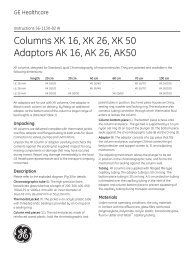
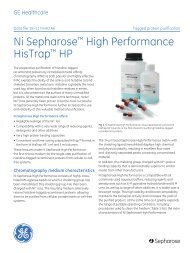
![[PDF] Sample preparation for analysis of protein, peptides and ...](https://img.yumpu.com/21549715/1/190x257/pdf-sample-preparation-for-analysis-of-protein-peptides-and-.jpg?quality=85)
![[PDF] Data File: rProtein A Sepharose Fast Flow](https://img.yumpu.com/21549316/1/190x253/pdf-data-file-rprotein-a-sepharose-fast-flow.jpg?quality=85)
![[PDF] MBP-tagged protein purification](https://img.yumpu.com/21548507/1/184x260/pdf-mbp-tagged-protein-purification.jpg?quality=85)
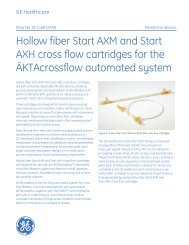
![[PDF] AKTA ready system Data file](https://img.yumpu.com/21540925/1/190x253/pdf-akta-ready-system-data-file.jpg?quality=85)
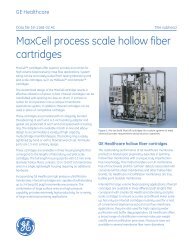
![[PDF] Data File - rProtein A/Protein G GraviTrap](https://img.yumpu.com/21539052/1/190x253/pdf-data-file-rprotein-a-protein-g-gravitrap.jpg?quality=85)
